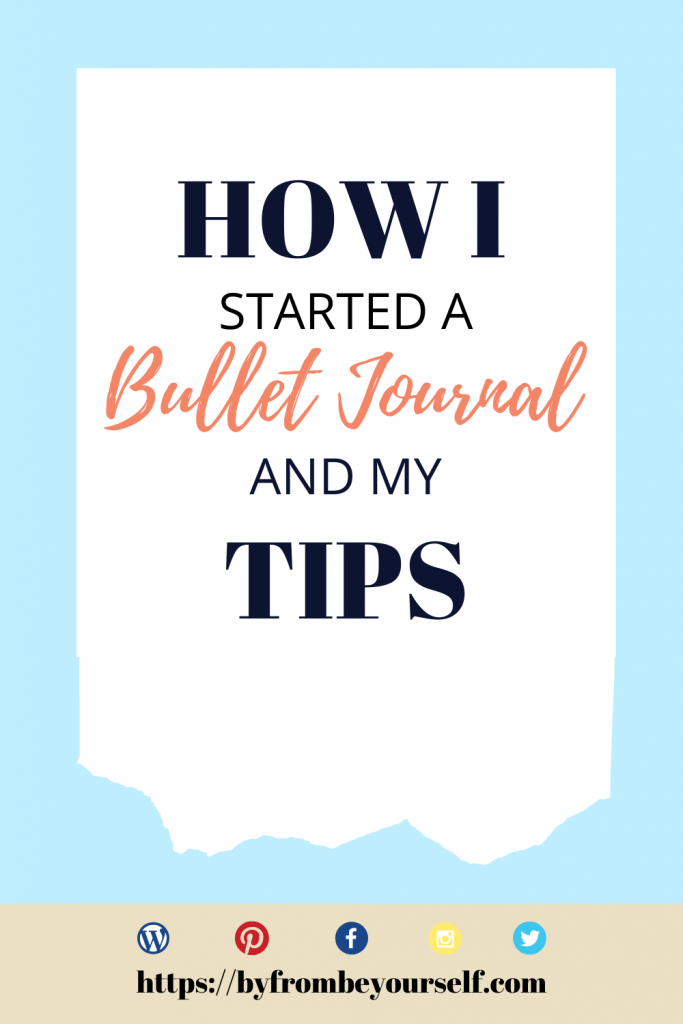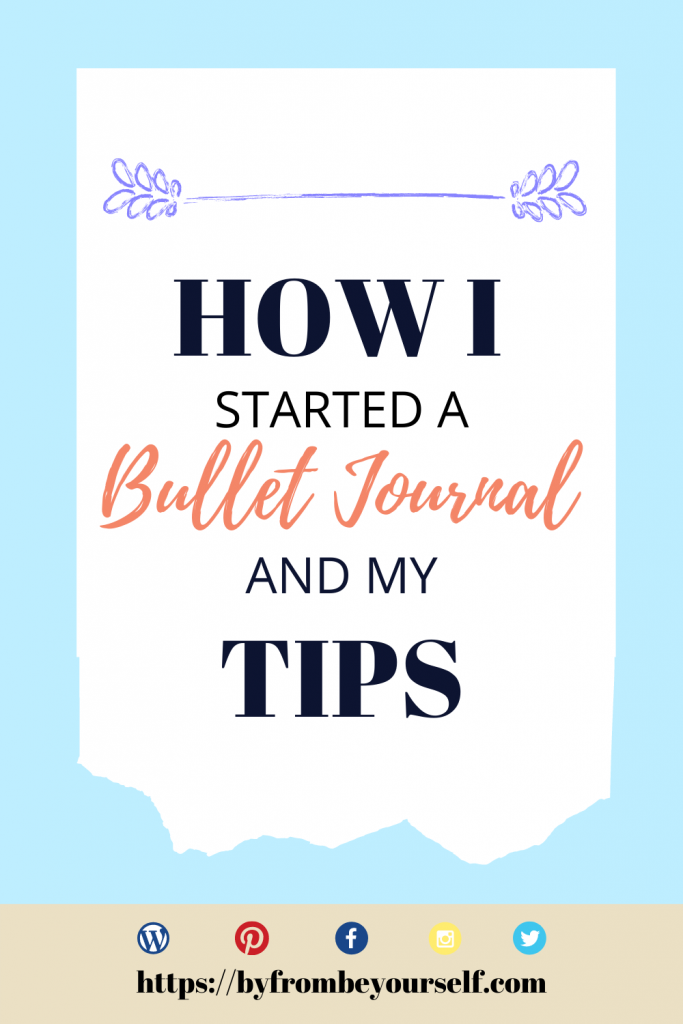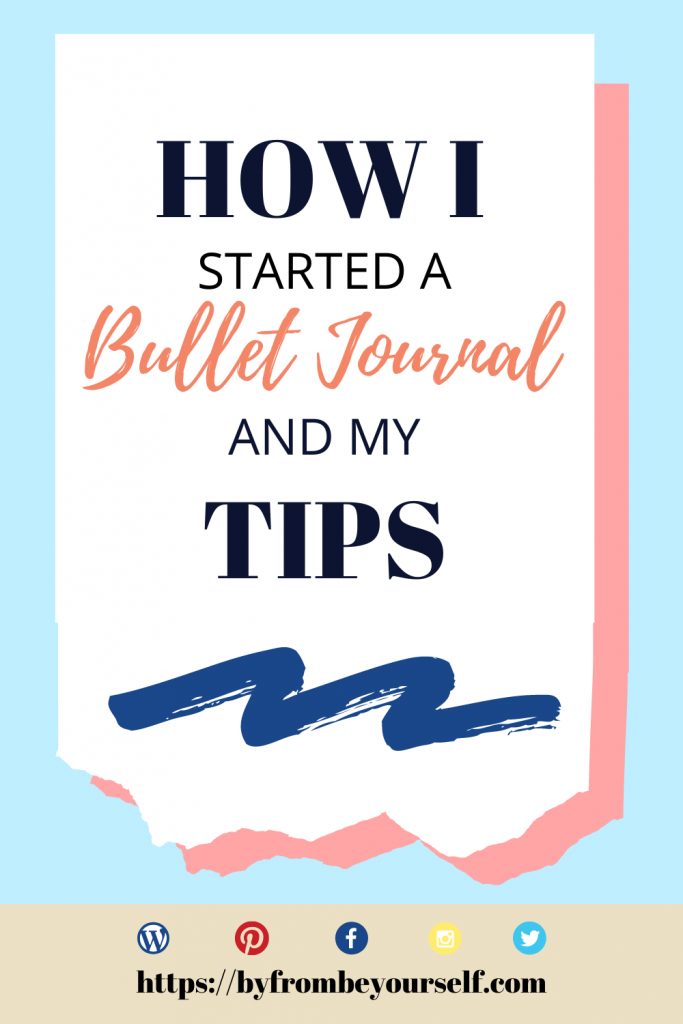We're an affiliate
We hope you love we recommend! Just so you know, we may collect a share of sales or other compensation from the links on this page at no extra cost to you. Thank you if you use our links, we really appreciate it!
The bullet journal is one of the greatest planning systems that I have used since the moment I started using planners. I love how customizable the system is and how everyone can make it their own in very simple ways. There are many ways in which you can make use of a bullet journal whether you want to use it the way it was created or add and modify things if you see fit.
What is a Bullet Journal
Let us start with the basics. A bullet journal is a rapid logging planning system created by Ryder Carroll in which you are encouraged to rapid log your tasks and events occurring in your life using a basic key created to classify your tasks, events and other matters with a variety of bullet points and signifiers.
By using a key and index that is recommended to use, you will be able to get the bullet journal experience to its fullest and then go from there to grow it into a more personalized version to fit your needs.
What I consider to be the best thing about bullet journals is how customizable it is. It allows its users to record the past, keep up with the present and plan for the future. If you want to learn more about the system in its purest form and how you can use it I encourage you to check out the official bullet journal system so that you get a clear view of the bullet journal system.
In this post, I will be giving you my recommendations on things you may like to consider when starting a bullet journal based on my experiences. We will go through both the supplies and the spreads.
You probably want all the supplies and all the craziest spreads out there to create a piece of art on each page. And by all means, be my guest if you want to, but try to not be harsh on yourself if you don’t have the time or the inspiration to do so. Remember that the most important thing is to find a system that works for you and your needs and everything you need to get a hold on in your life.
It took me a year of watching bullet journal videos and collection lists to finally take a step in starting my bullet journal. My biggest recommendation so far is to start small. By small I mean small, petite notebooks and supplies to start planning in the simplest of ways on a monthly basis. I know, you may be thinking “I don’t want to start small, I want all the spreads ever imaginable in my bullet journal.” If you believe that you can start a notebook and whether you use it for bullet journaling or not you will have a use for it, then go ahead and get it; but don’t just get it just for the sake of it. Remember that you can use this system in any type of notebook or journal.
When I tried the system I basically kept it the same way as it was developed by Ryder Carroll with a few collections I saw on social media that I liked in a little blank notebook I had lying around. I truly encourage you to check out the official bullet journal website as well as check out the video created by Ryder Carroll himself explaining the whole system if you want to get a better comprehension of how the system works.
The Notebook
When it comes to the journal I considered a lot of stuff but that’s because I’m me and I can’t help myself in doing lists of pros and cons. You can just use a random notebook that you have lying around and if you are, skip ahead because you don’t need to hear all these things I considered when getting a notebook and start doubting yourself and not use the notebook you had previously decided to use. If you still are interested in different things to refer to when getting a journal then read away.
The template of the page is something that was and still is important to me when it comes to the journal that I use. Even before I started bullet journaling I was really picky with the sort of template I liked to write on. By that time I had just tried the dotted template and concluded that it wasn’t for me to bullet journal on but as time passed by I realized that I enjoyed having the dots when I drew. I like ruled pages but I knew that the lines would bother me eventually. Now, when I tried graph paper, not any graph paper, 4mm graph paper, I saw the sun and the stars (I may be exagerating a bit on this but for real). I had previously always liked graph paper but it didn’t convince me because I thought that the squares were too big but when I tried the 4mm graph paper I had in one of the journals of a set that was part of Disney’s Oh my Disney collection, I found my perfect match. This is very specific but my recommendation is to start with what you have or try different sorts of pages if you are interested in doing so. And by that, I don’t mean to get a journal in all the templates but maybe you can print out a page or make a little template yourself just so that you can try them out.
The official bullet journal itself is dotted and by a brand called Leuchturm and a lot of people like it and others just use other journals that suit their needs. Here are two videos that I found really descriptive bullet journal notebook comparisons.
- Mega Notebook Comparison by Boho Berry
- Which Notebook is the Best for Bullet Journaling?! | STATIONERY SHOWDOWN by AmandaRachLee
Some other thing that I think you might want to consider when getting a new notebook or the journal you will be using is the weight of the paper also known as gsm. The higher the gsm the thicker the paper aka the more it can hold when it comes to inks and mixed media you may want to use on it. The reason you should look into this is that if you are planning on using heavy inks, markers or watercolors, you will probably need a high-quality paper in your notebook. The quality of the paper is both based on the type of paper and on the gsm. Between both, it determines the quality and what sort of inks the paper can hold. I don’t tend to use markers or any of the mentioned before in my bullet journal and my pen does not bleed through so I didn’t need to worry much about the quality of my paper.
Other things that people like to consider when getting a bullet journal are if it has numbered pages and an index. Those things are kind of important because they are part of the original bullet journal system that we discussed and people would most likely not have to think about creating their indexes and number all of their pages. I personally don’t mind numbering mine but I see how it can become annoying.
At first, I used little blank notebooks I had laying around the house and then, I started making my own journals with regular printing paper and putting the template of the 4mm squares behind the page that I was currently using so that I could structure my spreads. I made my journal following a bookbinding tutorial made by Sea Lemon on Youtube that I recommend you check out.
Writing Utensil
You are going to need a writing utensil to use in your bullet journal. You can use a pencil or any pen or marker of your choice. There are a few things you might want to consider in case you choose to use a pen. If you are using a pencil or a pen that you already like there’s no need to go through these considerations. Technically you can use whatever utensils you have at hand and that’s great but if you are a little bit perfectionist like I am, I think you will be able to get a lot of this checklist.
- Ghosting or Bleeding= Ghosting is when you can see a shadow of what you wrote on the other side of the page you wrote on and bleeding is when the actual ink goes through one page to another and maybe a few of the following ones. This effect works in conjunction with the quality of the paper of your journal. You may not mind ghosting but bleed through a page is quite hard to get around. If you can, let me tell you, you are a true champ. Depending on the pen or marker and journal you are using, these two things vary.
- Quality of ink= the quality of the ink is important because you don’t want it to be ink that just sits on the page and then smudge or ink that doesn’t flow smoothly enough that you have to go over and over again on the same spot for it to come out.
- Comfort= You need to make sure the pen you are using is comfortable to use for you and it doesn’t make your hand cramp because you are going to be using it quite a lot.
Now, if you are the kind of person who doesn’t really mind what writing utensil you are using then any of what I just said won’t matter to you. For the ones who are interested in trying new pens and finding the perfect one that qualifies and fits all of their needs; if you think you will need to spend a lot of money on pens, let me tell you that it isn’t really necessary for that to happen.
You see, you may be good to go with the normal ballpoint pens that come in packs of ten or so. I actually like them a lot, not for bullet journaling because I write really small and they don’t work for what I do in my bullet journal but you may be able to take a lot of use out of them. They aren’t blotchy, at least the ones that I use, and the last quite a long time.
There are many sorts of pens and I truly believe that it is a process of trial and error or success with them like it is with bullet journaling itself. There are ballpoint pens that come in fine and a great variety of thicknesses which are the ones that I prefer. Gel pens, that are mostly known for their fluid ink and smoothness and in some cases, are also known for smudging and bleeding through the page depending on the pen and the amount of ink that releases with each stroke. There are also felt tip pens that as you can derive from the name have a felt tip. And if you go all out and fancy, there are fountain pens who are a little bit more tricky and unconventional than the others but still good and like I said, quite fancy. All of these pens come in different thicknesses and quality. I will be leaving down below the ones that I use and for what I use them.
The Ones that I use
Like I said before when it comes to pens is truly personal choice and taste. I recommend you to try them out for yourself because at the end of the day it comes to personal preference. For instance, a lot of people love felt tip pens and swear by them but for me, I don’t really like the feeling of writing with them and for other people, this might be the other way around with ballpoint and gel pens.
Extra Supplies
Now that you got your journal and your pen, I will be talking about some extra supplies you might be interested in getting if you think that you may need them in your essentials. You definitely don’t need the supplies I will be mentioning going forward, with the journal and the pen you have everything you need to start bullet journaling. But I have found all these supplies have come in handy for when I work on my bullet journal.
- Pencil= If you are already using a pencil as your main writing utensil in your bullet journal then this won’t cause many effects in your planning. But let’s say you are using a pen and you like to add some sort of structure to your bullet journal spreads and collections or just write events that you are not sure of for the sake of not having to cross them if they get canceled, a pencil, will come quite handy at moments like that.
- Eraser= If you are not using a pencil then this is irrelevant to you but if you are, this is pretty self-explanatory whether you are erasing your pencil marks or just erasing something you wrote while using your pencil.
- Whiteout= If you are using a pen and aren’t interested in doing everything with a pencil yet you don’t want to have to deal with any pen mistakes, a whiteout is great to erase any of those little oops.
- Ruler= I love rulers and straight lines and I couldn’t live without my ruler in my bullet journal. That is my personal preference and what I consider to be a must in my bullet journal essentials. (By the way, if you want me to make a full blog post on all of my bullet journal essentials, make sure to leave a comment down below.) A lot of people are amazing doing straight lines by guiding themselves off of the dots or squares in their journals, but for me, that isn’t the case and I don’t personally want to risk it. And again, remember, with this sort of system, you do you boo.
Those were little extra supplies. Now, if you want to create super artistic and/or colorful spreads there are some other supplies you might be interested in.
Artistic Supplies
Let’s first go into the most popular ones: markers and calligraphy pens. They are great if you are using a color code in your bullet journal or if you just want to add a pop of color here and there. Calligraphy pens can sometimes be quite expensive, that’s why I always recommend the amazing and affordable Crayola super tips. I have used them from the beginning and since I learned how calligraphy and lettering worked and also, watched a couple of YouTube videos about it, I was able to do calligraphy with them.
Now, if you want something a little bit fancier, you may have heard of Tombow’s Fudenosuke pens and dual tip brush pens. They come in a great variety of colors and are often used to do lettering and calligraphy. I recommend you first try the super tips because the Tombow’s are a bit of an investment. Though if you feel you will take a lot of use of them and want them I suggest you check out places like Joann and Michaels because they often have coupons and sales on them. But like I said, I have only used the Crayola super tips and find them just perfect.
I wanted to mention before I go on, that I don’t use markers on my journal because I made it out of regular printing paper and though they may not bleed, they do ghost and some of them do actually bleed through and I just personally don’t want to deal with that in my bujo.
Paints and watercolors are quite an interesting and fun media to use in your bullet journal but when using them, things can get quite messy depending on the supplies you have previously selected referring to the journal and your writing pen.
Depending on the sort of paper your journal has, it can determine how it manages these other crafty mediums. Also, when it comes to watercolors and markers, you need to see if they are waterbased or not because when putting watercolor over something you have written with a water-based marker, the whole thing will just smudge away.
Something I’ve seen bullet journalers do to add watercolor or paints into their bullet journals is taking another piece of a higher quality paper and putting it on the bullet journal add the paint or whatever it is you painted.
Coloring pencils are my jam, I couldn’t love them more. They work perfectly for what I want which is to sometimes do designs on my pages and to use in my habit tracker. They don’t bleed through and to this day I don’t remember having any smudges in my journal caused by them (emphasis in the caused by them, I have had some accidents with pens in my journal for sure). I once again use the traditional Crayola coloring pencils and they work amazing at least for my taste. I have been using them from the beginning and so far I don’t have any complaints.
Pages/ Spreads
The pages of a bullet journal are completely up to you and what you need in your life. You could just use the bullet journal system in its simplest way or you could add other elements that you believe will come in handy for your day to day life. As well as almost everything regarding this system, it is based out of trial and error or success and awesomely customizable. If you want to know which spread I started with that I recommend reading on.
From the beginning, I knew I wanted a bit more structure than the system originally has but still, I wanted to add most of the main elements. The key is quite useful and pretty adjustable to a lot of lifestyles that’s why I added some of it into my first little bujo.
I didn’t add a future log because at first, I was using little tiny notebooks as monthly bullet journals.
I added the month at a glance just so that I could see all the dates at once in a structure I was used to seeing and a monthly log because I just found it the most amazing thing ever created and till this day I have not had a month in which I have not had it. I recommend you just check it out and if you want to have a little backup just in case, you can do a traditional boxed calendar spread.
Many bullet journalers use habit trackers, gratitude logs and mood trackers. I don’t personally use the ladder because it is just too much for me but a lot of people find it quite useful to track their moods. As for the habit tracker and gratitude log, they are one of the OG’s for me. I don’t tend to go too fancy with this spread because I just use it functionally and something that I am going to reach for daily. If you want to see how I set up my spreads for January make sure to stay tuned because it is coming up soon.
And there are so many more spreads and collections you could try out; honestly, the possibilities are endless. Here are some bullet journalers I recommend you to check out whether you are into really artistic spreads or simple and minimalistic ones.
Artistic
They all have beautiful creative spreads and not all of them are that difficult to make when you see the video and how is set up.
Minimalist
Remember that we are all humans and that there is no need for perfection for something so personal as your bullet journal. If you are interested in seeing my 2020 bullet journal setup as well as my January one and other fun content, make sure to subscribe to my email list and check out my social media so that you can keep up with the content I will be putting out each week. Also, just in case you forget to check them out, I will be uploading new blog posts every Tuesday and Saturday.
Be Yourself, Be Happy, Be Human.
Xoxo, Patrick.





Hi, so happy to find a place were creative and not perfection makes more human this world. I wish you a great success in this great journey.
Thanks for bringing us this opportunity to learn and share from this page.
The best and god bless you my lovely daughter!!
Truly yours,
Dad
Thank you for your support! Love you always!!!
Congratulations for your blog. I can’t wait to read the next one. I am pretty sure you will have a big success through your life. Hugs and kisses!
Thank you!!! Hugs and Kisses to you too!!!
Great information and sources. Thanks for sharing
Thank You!!! I appreciate your comment!!!